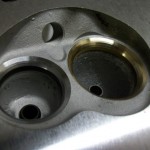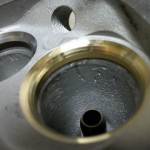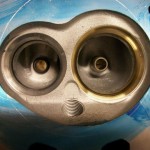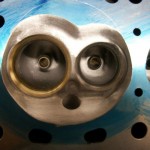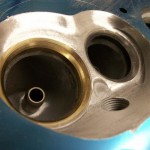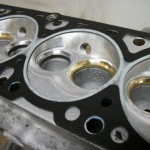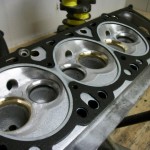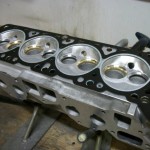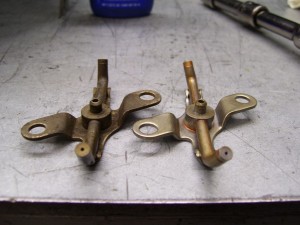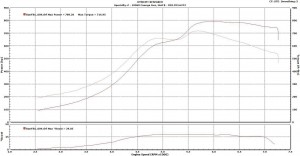Its no surprise that the more our technology improves the more we take the article we are working on and put it through more stress. Our technology also has combat this issue with increased efficiency as well. Its a pure trade off of sustainability and consistency. The more we push the more it wants to resist so we work harder at ensuring we don’t damage what we are trying to obtain (HP/TQ etc etc).
I want to talk today about the oiling system in VG30 engine. For years this system has worked as a standard method of oiling. It was engineered and designed to work for economic status in mass produced outfits. This particular system is referenced to be known as a Low Speed Oiling system which utilizes the cross drilling of the crankshafts oiling ability (see images below). This system works great for outfits that are used for everyday use where it doesn’t see excessive RPM and load and isn’t put through an strenuous scenario continuously. Nissan did a good thing in utilizing this system in every platform (to my knowledge). With the introduction of the performance world increasing power and tq on this system put this LSOS into a crippling disadvantage. For years people have been running the stock system relying on the age old theory of “If Nissan ran it like this, it should be fine for what I’m doing” or “He’s making X amount of power and he’s still using the stock system” well that may be true but that doesn’t mean its right. Nissan uses the system as an economic basis to ensure their engines and protect them from oil starvation. But this only truly works on the outfit running at optimum conditions. Essentially where the manufacture rates the power output based on red line performance from the factory, anything above this and you start damaging the system as a whole. Fact of the matter is, if you are driving beyond normal driving practices essentially city driving you are putting the LSOS in a deficiency category. Of course many owners that take their cars and upgrade them to produce more power really put the engines lubrication system in a backwards spiral and eventually to a catastrophic demise (bearing failure)
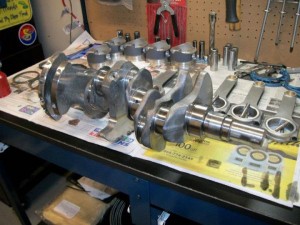

So what does this all equate to? Well its simple really, cross drilled crankshafts are old technology and are the demise of the oiling system in any engine that utilizes it. The more power/abuse you put on this system the faster it will wear out. I’m not going to sit here to tell you that others are wrong for not addressing this issue in their engine but I will say that it should be at the top of the list of things to update/upgrade if you are planning on building your engine. We all know that the VG30 (and pretty much any other Nissan with a cross drilled crankshaft) has rod bearing issues. Some pin the issue on rod journal size, oil pump volume capabilities, oil pan problems etc etc. Those do play some part in the issue but it is significantly smaller than the direct oiling system provided through and in the crankshaft. With this specific oiling system what happens is quite interesting. If you can imagine for a second a pencil and at the top of this pencil you’ve glued a round disc. You take that disc once its been adhered to the pencil and you put it in any fluid, lets use oil as an example. Now take that same pencil with the disc that has all the oil on it and move the pencil back and forth between your hands (rolling it forwards & backwards) What you will see is that the oil is being slung off the disc on all axis of the surface area. What you are seeing is the birds eye view of what the oiling system does in a VG30. So you’re thinking..“looks fine to me, whats the big deal?” Well the deal is that once the oil is left the disc is much drier than before when it had all the oil on it, now add oil pressure lets say 90psi (average for the VG30 platform) so now not only are you slinging the oil off the journal drying the bearing and journal out but you’re actively forcing the oil off the wear surfaces. FAIL ON SO MANY LEVELS!!! This is the culprit for rod bearing failures in approx 90-95% (I’d professional say) on the VG30 platform.

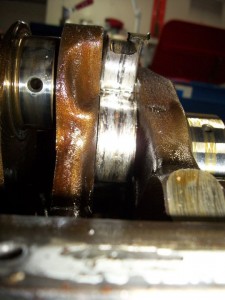
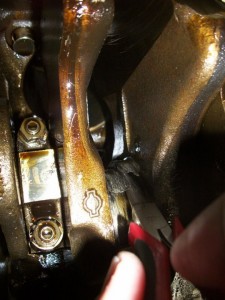
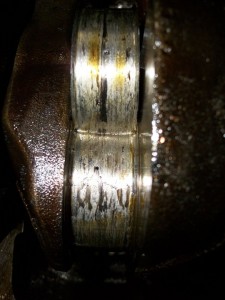
So how does one fix this issue? How can I eliminate further damage and more money being sucked out of my wallet? Well if you’re in the midst of building your engine, any engine that uses a cross drilled crankshaft you can find a machine shop that can modify the crankshafts oiling system to properly distribute oil. Here at EP Racing we do this to nearly every engine that is built. The customer is educated on the involvement and why its crucial and how it will benefit the engine and on a long term benefit the customers wallet. I am fully setup to handle this form of alteration in house and have been doing so for nearly 3 years now. To date I am the only Nissan machine shop that is dedicated in improving the oiling systems and that offers this upgrade.
I want to share with you a report written by David Reher of R.M.R. E here in Arlington, TX. His information is invaluable and I am lucky to have a close friend that was the head machinist that used to work in their machine room. With information from my friend and Davids experience and knowledge of this issue it sealed the deal in closing the door on an apparent problem that’s plagued the Z32 and other platforms for years.
Written by David Reher
“I’ll begin with a rather bold statement: Don’t use a cross-drilled crankshaft. There are a few exceptions to this rule, but under most circumstances, a cross-drilled crank is going to cause big problems.
Unfortunately cross-drilling is one of those terms that’s become part of the jargon of hot rodding. People who know very little about racing engines have heard of a “cross-drilled crank,” and mistakenly believe they’ve got to have one. In fact, cross-drilling simply refers to the position and routing of the holes that carry pressurized oil from the main bearing journals to the connecting rod bearings.
In a cross-drilled crankshaft, oil feed holes are drilled completely through the main journals so the passages are open on both ends. Holes from the rod journals are then drilled at an angle to intersect the holes in the main jouranls at the centerline of the crank. This system was thought to ensure a continuous supply of oil to the rod bearings because one end of the passage drilled through the main bearing is always exposed to the pressurized oil in the upper main bearing insert.
So what’s wrong with this picture? The pressurized oil that enters the feed hole through the main bearing journal must overcome the centrifugal force created by the rapidly spinning crankshaft before it can reach the passage to the rod journal. If the pressure created by the oil pump is not strong enough to counteract the centrifugal force that is pulling the oil away from the rod journal feed hole, then the rod bearing is starved for lubrication. Since the pinwheel effect of the centrifugal force increases with rpm, when the rod bearing does run dry and seize, the resulting carnage is usually catastrophic.
I learned my lesson about cross-drilled crankshafts the hard way. Back in the early ’80s we started to turn our engines faster. We’d been running stock Chevy cranks in our 287-cubic-inch small-blocks and B/ED motors without any problems. Eventually the supply of usable cranks became exhausted, so we ordered aftermarket cranks – “California cranks” as my Texan friends called them. These cranks were much prettier than the factory forgings, and they all had trick cross-drilled main bearings. It didn’t take long for those cranks to turn blue when the rod bearings burned, sometimes on the first or second dyno pull. Then we’d bolt in an old 283 crank and the engine would live forever. So what was the difference? The difference was the cross-drilling.
Today most racing crankshafts have a “high-speed” oiling system, which is essentially just how Chevy drilled those stock cranks. The oil feed holes for the rod bearings intersect the main journals at or near the surface of the journals. The pressurized oil does not have to overcome centrifugal force to reach the oil feed holes for the rod bearings, so the supply of lubrication is constant even at high rpm. There have been some refinements made to the angles and positions of the oiling holes to “time” the oil supply, but the basic design hasn’t changed significantly.
It’s easy to spot a cross-drilled crankshaft. Insert a piece of welding rod or coat hanger wire into the oil hole drilled in the main bearing. If the wire comes out the other side, the crank is cross-drilled. My advice is not to use it.
It is possible to crank up the oil pressure high enough to overcome the negative effects of cross-drilling. However, excessive oil pressure creates its own set of problems, increasing parasitic losses due to windage, excessive oil on the cylinder walls, and the power that’s consumed by turning a high-pressure oil pump.
It’s possible to manufacture a 5-inch stroke big-block crankshaft without cross-drilling the main journals. However, as the stroke becomes longer than 5 inches, the overlap between the main journals and the rod journals is reduced to the point that there is insufficient material for the oil feed holes. The crank manufacturer must then change the angle of the holes and drill them to intersect a cross-drilled passage in the main journal. When using this type of long-stroke cross-drilled crankshaft, it’s absolutely essential to increase the oil pressure and install a big dry-sump tank, because this engine is going to circulate a lot of oil.
It’s critical for anyone assembling an engine to inspect the crankshaft carefully. The first thing we do with every crank that comes into our shop is get out a pen light and a welding rod and check the oil holes. It’s not uncommon to find an oil feed hole that’s blocked or not drilled quite far enough. When assembling an engine, make sure that every oil passage is open and drilled where it is supposed to be.”
Here is more information written by SCAT Industries (SCAT CRANKSHAFTS)
SCAT TECH
“SAY NO TO CROSS-DRILLING”
“The shortest distance between two points is
a straight line.
Nowhere is this more true than in the straight shot oil system
designed into all SCAT cranks. With the throw at 12:00 the oil enters
the main bearing between 6:00 and 9:00 depending on journal size
and stroke. The oil passage goes straight to the throw and exists at
approx 1:30 to 2:00. RPM of the crankshaft unlike cross-drilling has
no effect on oil delivery to the throw.
What is cross-drilling?
Cross drilled cranks have oil feed holes drilled completely throughout
the journals. Sometimes mains only and sometimes mains and
throws. An angle hole is then drilled from the throw to the main on
the center-line of the crank. Some think this system, because both
ends of the cross drilled hole are exposed to oil supply, will ensure
continuous supply of oil to the rod journal.
WRONG!!
Pressurized oil must enter the main journal and overcome centrifugal
force of rapid acceleration or RPM to reach the center of the crank
before the oil can travel to the throw. Only increased oil pressure will
overcome the “crack the whip effect”. In most cases it will not and
the result is a very expensive rod failure. For sure you do not see any
NASCAR team using cross-drilled cranks.
SCAT’S COMMITMENT
SCAT is committed to manufacturing only the highest quality
crankshafts and we WILL NOT cross drill cranks even though the
process is easier and cheaper.
So after reading this information myself and talking to Mr. Reher personally as well as involving my friend in the idea I wanted to do about resolving the issue with the crankshafts I pressed forward in doing the work. From day one since then I can happily report not a single rod bearing issue has ever been reported and some of these engines that are utilizing this updated system in the stock crankshaft run in SCCA events, not to mention quite a few drag race applications as well. Some reading will say “well man all you’re doing is regurgitating information”. To some extent yes, but this import scene has never really dived into this issue like I have. I’ve discussed on several occasions the importance of doing this coupled with a few other upgrades to be included with the outfit and some listen and took note and others stuck their noses up at it and figured I was just full of crap. Well the proof is in the pudding folks. There’s a reason for everything and if done properly and well executed can prove significant gains.
So next time you’re in the situation where you need your engine rebuilt, I want you to think about what I’ve said here in this tech article and think about what Mr. Reher has said as well. Its important to me that my future customers know certain criteria to better help them in making important decisions. We all know money is a factor in building and everyone has a budget but I strongly urge individuals to fix the apparent issues first before one goes and dives in the “building HP” category, because your engines no better than its ability to stay alive.
Thanks for reading.

